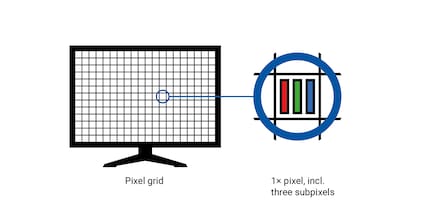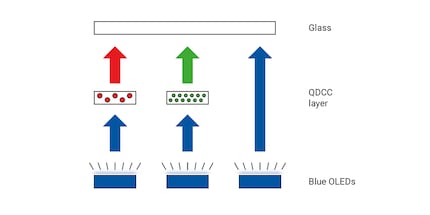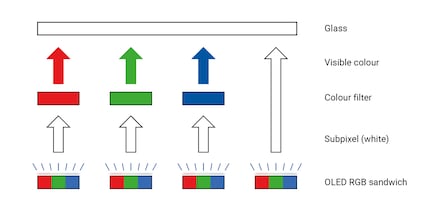
Background information
OLED vs. QLED: battle of the TV technologies
by Luca Fontana

Samsung is aiming for a big OLED comeback with its new QD OLED technology. But the company is keeping strangely quiet about it. So, here are the most important questions and answers.
The rumours are true: TV manufacturer Samsung is to launch its first marketable OLED TV this year, as unveiled at CES 2022. This comes as no surprise. As early as in 2019, leaks surfaced that the South Korean tech giant was planning its comeback on the down low. But the fact that those behind it are staying tight-lipped in official statements is odd.
Samsung’s version of OLED sounds very promising. In fact, LG Display could even lose its monopoly on the manufacturing of this superior screen technology. Unlike LG, Samsung combines OLEDs with nanoparticles known as quantum dots, which have so far only been used in LCD televisions.
Let’s clear up the most important questions.
OLED pixels are LEDs that contain carbon. The special thing about these pixels is that they not only generate the image, but also light. LCD pixels can’t do this; they only create the image. They require additional backlighting, which consists of a separate layer of LEDs. However, these LEDs can’t (yet) be manufactured to be as small as pixels. As a result, precise brightness control – i.e. per pixel – isn’t possible. This has a significant impact on image quality.
See a previous article of mine for more on that topic:
Both technologies have pros and cons. The decisive advantage of OLED over LCD is the fact that it can display true black. This – along with the resulting better contrasts – is made possible by the pinpoint brightness control. However, OLEDs don’t shine as brightly as conventional LEDs. The problem is this: you could indeed increase brightness by supplying OLED pixels with more energy. However, this would lead to increased heat development in the pixels. And this, in turn, would accelerate the wear of the material and lead more quickly to burn-in – that is, ghostlike parts of images that persist on the screen no matter what you put on.
Nevertheless, the industry consensus is that, as of today, OLED TVs produce the best picture money can buy. As CNET expert David Katzmaier explains, OLEDs are superior to LCDs. Although OLED TVs are available from many manufacturers, the panels are built by one brand only: LG.
Samsung and LG have been battling to be top dog for years now. Who has the better TV picture technology? LG Display is a subsidiary of LG that has quite the monopoly on OLED panels for TVs. Unlike the competition, LG Display found a way to improve the brightness of screens years ago without significantly increasing the risk of burn-in. How?
Well, every TV consists of millions of pixels arranged in a grid. Each individual pixel contains three tiny subpixels:

What LG Display did is add an additional white subpixel to the RGB grid. This white pixel’s only function is to provide more brightness through its light. This significantly reduces the energy load per subpixel – and with it the risk of burn-in. This technology is known as WOLED.
No other manufacturer has explored WOLED technology as quickly and efficiently as LG Display. Not even Samsung Display, Samsung’s TV panel manufacturing subsidiary. And because the cost of research and development is exorbitantly high, it’s easier for everyone to buy OLED panels from LG Display instead of researching, developing and building them themselves. Even if no manufacturer admits it, it’s really an open secret that Sony, Philips and Panasonic all buy their OLED panels from LG Display.
But that’s about to change.
Samsung has tried its hand at OLED panels before. But in 2014, after a series of failed prototypes, it announced its withdrawal from the OLED TV business.
Since then, the manufacturer has repeatedly spoken out vehemently against OLED panels in TVs, precisely because of the risk of burn-in. Of course, it never would have occurred to Samsung to admit defeat and buy the coveted panel technology from its archrival LG. Instead, Samsung opted to market its LCD TVs with nanoparticle technology and mini-LEDs as the real star on the market, known under the name Neo QLED.
Outside of Samsung’s circles, this assessment was hardly met with agreement – with the exception of QLED partner TCL. It was not uncommon for experts to speculate that Samsung secretly regretted its departure from OLED, even though Samsung remains the largest manufacturer of TVs in the world.
TV market share measured in terms of shipments
Samsung Electronics believes that the existing OLED panel technology needs technological improvement before it can be used in the production of televisions.
It appears that said technological improvements have now been made. It’s no exaggeration to consider Samsung’s appearance at the most recent CES historic: Samsung presented its own, new and marketable version of OLED. It doesn’t yet have an official name. However, the term used by experts is Quantum Dot OLED, or QD-OLED for short.
LG introduced the white subpixels to create an even brighter image without risking more burn-in. Samsung, on the other hand, relies on nanoparticles – the very ones that it already uses to ensure particularly pure light in its LCD televisions. This is what makes nanoparticle TVs better than regular LCD TVs. And now, Samsung aims to apply the same principle to OLED TVs.
How? To start with, Samsung uses blue OLEDs only. Instead of going for conventional colour filters like LG, Samsung has opted for a nanoparticle layer that absorbs the blue light of the OLEDs and recolours it. This works thanks to a phenomenon in physics: the nanoparticles vibrate based on their size, which we in turn perceive as colour. And all this is possible without any loss of brightness. This nanoparticle layer is called the «quantum dot colour conversion» layer, or QDCC for short.

It’s a very small change in the architecture of an OLED pixel – with a potentially huge impact.
In theory, Yes. Samsung wants to combine the best of both worlds in its QD-OLED panels. Here’s what this means:
The idea of using nanoparticles as a colour filter replacement is not just good – it’s ingenious. Why? Because LG’s colour filters come with a technological disadvantage. Let’s recap: a WOLED pixel consists of four subpixels. In each subpixel, the red, green and blue OLEDs shine equally as bright – which we perceive as «white». The filters above it are what block the unwanted colours. A green and blue filter, for example, will make the subpixel glow red. This is how each subpixel is assigned its own colour.
Here’s a graphical representation of how this works:

Here’s the problem: filtering like this reduces the luminance of each colour, resulting in lower brightness. That’s why LG adds an additional white subpixel. It increases image brightness – but also washes out the other colours. Mind you, the resulting OLED colours are by no means bad. On the contrary, they’re great. But they don’t exploit their full potential. I’ve explained the physics behind this in more detail in a previous article:
Samsung’s nanoparticles, on the other hand, don’t rely on filters. Instead, they recolour the bluish OLED light. This is crucial; with QD-OLED pixels, colours don’t lose luminance – or brightness. This allows them to exploit significantly more of their potential. Here’s what this means:
As mentioned above, more energy equals more heat and that, in turn, equals a higher risk of burn-in. Samsung’s new architecture avoids this issue – at least in theory.
Yes. Linus Tech Tips, for one, has tested it. Linus appears to confirm the theory in his test – though his reports should be taken with a grain of salt for the time being, as he was invited over for testing by Samsung, and his video was sponsored by Samsung.
However, Linus is considered a reputable expert. His opinion matters. Linus also states that Samsung has never had an external tester try out new technology in advance, and certainly not with external source material and devices that belong to the tester, not Samsung. If this is true, it’s another testament to Samsung’s great confidence in its own technology.
Whatever the case, the numbers Linus presents in his video are impressive. Let’s start with the brightness. We’re comparing LG’s Evo OLED panel and Samsung’s Neo QLED panel from last year. I got the numbers from rtings.com. The columns stand for the portion of the display measured, i.e. 2%, 50% and 100% of the display.
| 2% | 50% | 100% | |
|---|---|---|---|
| WOLED
(LG G1 Evo OLED) | 846 nits | 281 nits | 169 nits |
| Neo QLED
(Samsung QN90A) | 1,363 nits | 1,153 nits | 735 nits |
| QD-OLED | 1,400 nits | 300 nits | 200 nits |
Nit is the unit of measurement for candela per square metre (cd/m²), i.e. luminance density or brightness. Please view this comparison of numbers as a guide only, as the nit measurements stem from different sources.
The overall brightness of the TV (100% panel size) reveals that there’s hardly any difference between QD-OLED and WOLED; an LCD TV will still produce the most visible picture in a light-flooded room. However, the comparison at 2%, i.e. very small image portions, is impressive. Think the sun, lanterns, and headlights: when it comes to those, QD-OLED outshines even LCD. QD-OLED TVs can also shine much brighter than WOLED TVs at specific points – without the use of additional white subpixels. This means more luminance, better contrasts and therefore more vivid colours.
In a press release, Samsung announced the certification of its display by SGS, one of the leading international product testing companies. The coverage of two colour spaces was measured. First, the DCI-P3 colour space that’s currently most commonly used for HDR and Dolby Vision content. Second, BT.2020, also known as Rec.2020, which is considered the colour space of the future. Again, here’s a comparison of QD-OLED with Evo OLED and Neo QLED.
| DCI-P3 | BT.2020 / Rec.2020 | |
|---|---|---|
| WOLED
(LG G1 Evo OLED) | 99.79% | 77.17% |
| Neo QLED
(Samsung QN90A) | 95.52% | 76.49% |
| QD-OLED | >120% | >90% |
Please view this comparison of numbers as a guide only, as the nit measurements stem from different sources.
QD-OLED far outperforms the other technologies – downright crushes them. At this point, it seems that no long-term tests are needed to predict that QD-OLED is set to produce the best picture in the next few years.
Yes. but not in the immediate future. LG Display’s current monopoly position is too strong for that. After all, LG Display is the only manufacturer of OLED panels for TVs. What’s more, Samsung will not, in fact, be the first to launch the QD-OLED TV, but Sony.
Wait, what?
It’s true: so far, the Japanese TV manufacturer is the only one to have announced a concrete model, namely the Sony Bravia A95K (pictured in the title image). Sales could start as early as May. When asked by the editorial team, Sony didn’t want to say where it’s sourcing its QD-OLED panel from. However, it stands to reason that Sony has bought it from Samsung Display.
Samsung does also plan to launch its own first QD-OLED TV this year. Upon request, Samsung Schweiz (Switzerland) wasn’t able to say when exactly this would be.
Samsung’s 65-inch TV with QD display has received the CES 2022 Innovation Award. While specific plans for commercialisation have not yet been determined, we look forward to offering new TV experiences to our customers in the near future.
According to well-informed industry insiders, the reason for the delayed launch could be internal squabbles between Samsung and Samsung Display. Could be, mind you; that hasn’t been confirmed.
Just at what speed Samsung Display’s factories will operate for QD-OLED depends on market demand. Demand, in turn, depends on the price of the TVs, which remains unknown as of right now. Not even Sony has released any numbers. For all these reasons, it’s unlikely that QD-OLED will cause major changes in the TV market in the short term.
No. Industry experts, including Caleb Denison of Digital Trends, predict that the first QD-OLED TVs will remain far too expensive for the average consumer over the next few years. This is consistent with what I’ve heard so far from well-informed sources; the retail price for a 65-inch model is expected to be around 4,500 to 5,000 francs. Give or take a few.
LG Display, on the other hand, has established WOLED’s position on the market over the past few years; the technology is more mature, more efficient and cheaper to manufacture than ever before. More and more people can afford the once uber-expensive OLED TVs. In addition, the fact that OLEDs produce a better picture than anything prior to QD-OLED still holds true.
This outlook is further supported by the following statement from Sony:
Besides the A95K with the new QD-OLED technology [...] the largest share of Sony’s range in the TV sector [...] is based on OLED technology, followed by TVs with LCD technology. All this to say that OLED technology is of strategic importance for Sony.
This could further explain why Samsung has been so strangely quiet about its own new QD-OLED technology: it’s still too expensive to put a quick end to WOLED. Add to that the fact that, for years now, Samsung has been working on Micro-LED – the LCD technology purported to be the real OLED killer. To be released soon. Next year? Or the year after that. The South Koreans have been postponing the market launch to bring said technology into our living rooms for what feels like an eternity. How exactly is QD-OLED to fit into this scheme? Samsung’s marketing department is certainly already racking its brains about that.
This leaves LG Display the time to respond with its own version of QD-OLED. And it’ll have to do so. LG is bound to resist buying panels from its archrival, just as Samsung has resisted buying from LG Display all these years. This is to the benefit of us consumers. Competition not only stimulates business, but also lowers prices.
LG Schweiz declined the editorial team's request for comment on QD-OLED.
Update March 18, 1:55 pm:
Heise Online claims to have discovered glaring weaknesses in Samsung's QD OLED. What's the issue?
Thanks to the comment column for the hint!
Cover image: Sony
I write about technology as if it were cinema, and about films as if they were real life. Between bits and blockbusters, I’m after stories that move people, not just generate clicks. And yes – sometimes I listen to film scores louder than I probably should.
Interesting facts about products, behind-the-scenes looks at manufacturers and deep-dives on interesting people.
Show all